2 In Ancient China Which Three Forms of Art Were Considered the Three Perfections?
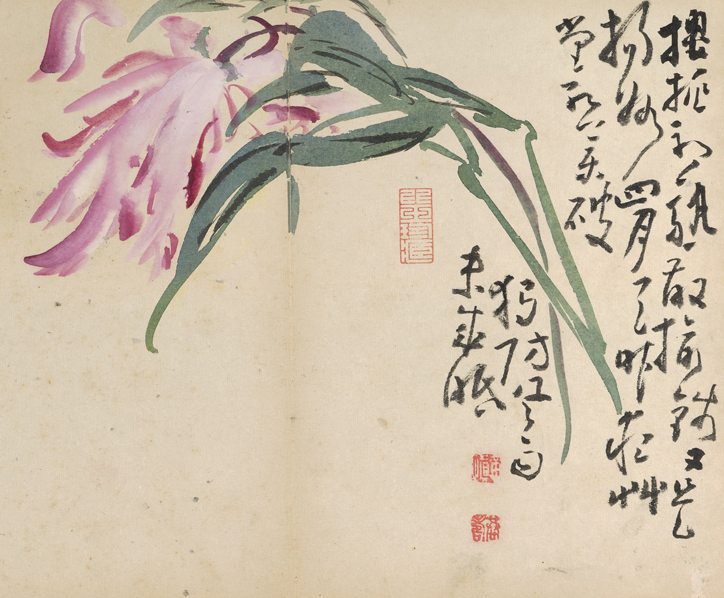
Inscribed by Huang Tingjian (1045-1105 on Li Gonglin 1049-1105's painting - Resting in Contemplation, courtesy National Gallery Victoria
The great interconnections betwixt poetry, calligraphy and painting in Chinese art will exist explored in an exquisite modest exhibition at the National Gallery of Victoria from 6th Dec 2013 until 9th June, 2014.
Master Li had a phrase he did not want to limited in words,
so with lite ink he sketched out a soundless poem
Three Perfections: Poetry, Painting and Calligraphy in Chinese Art is an exhibition of poetic works by meaning Chinese artists, uniquely combining the '3 perfections' calligraphy, painting and poetry to nowadays a harmonious whole.
The prove features beautiful and intricately detailed traditional Chinese paintings using calligraphic brushstrokes on paper and silk, many of which will be mounted equally hanging scrolls.
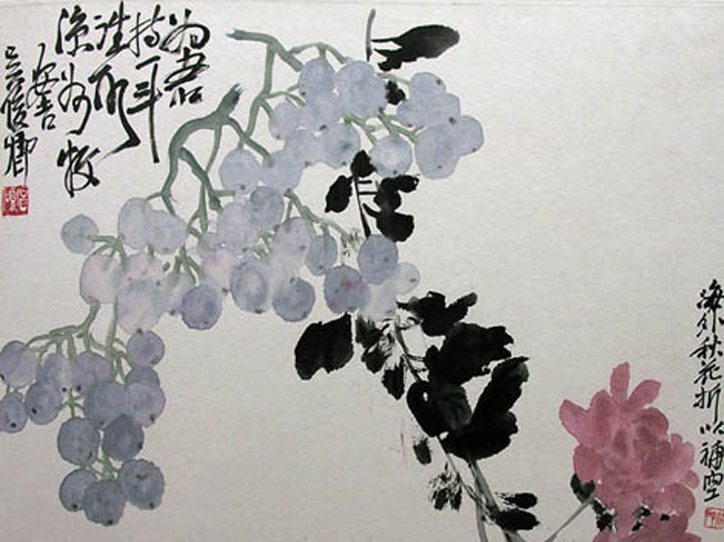
Wu Changshuo'south art displayed bang-up mastery of castor and ink
It volition display works past such luminary artists including Huang Shen (1687 – 1768), Wu Changshuo (1844 – 1927), Bi Haizhous (1954 – present), You Si (1954 – present) and the piece of work of Kim Hoa Tram (1959 – present) who is currently working in Australia.
Scholars and scholar-officials were taught the 'arts' of verse, painting and calligraphy during the 11th century in Red china, during the Northern Song Dynasty (960 – 1127). It is at this fourth dimension the development of press became central to a great flare-up of intellectual activity.
In 105 in that location was the discovery of newspaper, traditionally credited to the enuch Ts'ai Lun.
Feng Tao, traditionally regarded as the inventor of press, presented the royal family unit a complete edition of the classics in 953 and the Sung dynasty reaped benefits of this new aid to scholarship and learning.
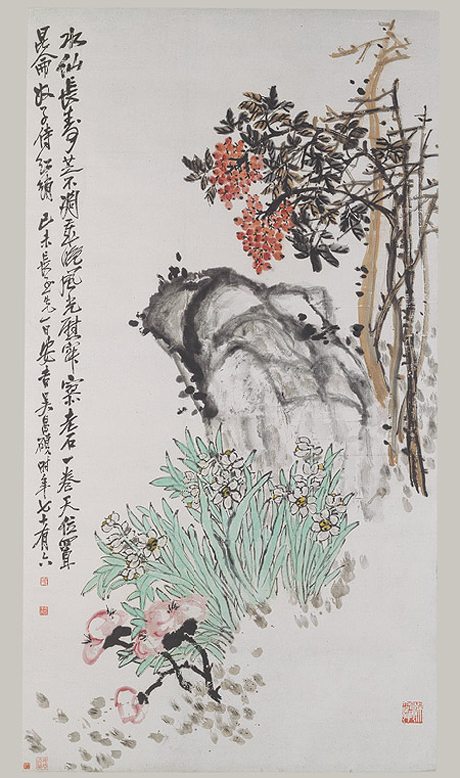
Spring Offerings, dated 1919 Wu Changshi (Wu Changshuo) (1844–1927)
During the ninth century poesy introduced by Po Chu-i became legendary in Chinese history. He insisted poetry must be understandable past 'quondam country women' and his style later influenced many modern Western writers.
His relationship with Yuan Chen, has been described equally perhaps the most famous friendship in Chinese history.
Coming together first in 802 they passed the Provincial and Metropolitan examinations, establishing themselves as scholars. They were given a pleasant chore in the palace library, just expected to turn up twice a month.
When they passed the Palace examination, prepare by the Emperor himself, Yuan established himself as someone too prickly to proceed around and spent much of his life in exile writing to Po.
Po's career was with the government and very distinguished. They met from time to time, writing poesy to each other and their friendship became a national establishment.
When they met for the last time in 829, for Yuan died in 831, Po recorded
"We drank together and when nosotros parted, with tears in his eyes, he gave me ii poems"
Do non scold me for still being here! I know I take stayed too long;
I take tried hard to say good-bye, just words volition not come
Let me stay, for few are left of our grey headed ring;
Tomorrow you lot may not go the chance of a meeting such as this
Po collated all his works into 75 chapters of prose and verse

Birds past Emperor Sung Huizong
Sung emperors reigned from 960 to 1279 when printing became primal to a swell burst of intellectual activity. They sought to recreate the splendour of the T'ang court building palaces, alluring writers and artists to their court.
They revived the University and established porcelain, lacquer and silk factories on the outskirts of the capital letter Kaifeng.
While the emperors avidly collected paintings, bronzes and antique jades, they did not hesitate to wield the brush themselves.

Procession of Sung Dynasty Emperors
During the Chinese Yuan dynasty (c1260-1368) knowledge of Mainland china first filtered through to the westward. Established by the Mongols, Kublai Khan gained the championship Smashing Khan by defeating his brothers and embracing Chinese culture.
In 1260 Peking became his wintertime majuscule and he rebuilt the city. In 1271 he announced the beginning of some other Chinese dynasty with himself every bit first emperor.
Naming it Ta Yuan, significant great origin, he governed forth Chinese lines, employing foreigners who travelled the length of the Silk Road.
The notion China was a land unlike any other found fertile basis in the western mind during the 14th century. Stories of the wondrous land of Cathay enhanced the idea its people were different, fascinating westerners.
To a European mind they were perchance a piddling fleck peculiar. Marco Polo stressed the idea the East was a land of precious gems, spices, and gorgeous silks and the first stirring of what would eventually become known as the China Trade grew out of Marco Polo's reports sent back to Venice .
This was when Europe was emerging from medievalism, and the effects of his accounts of what he had seen created a sensation.
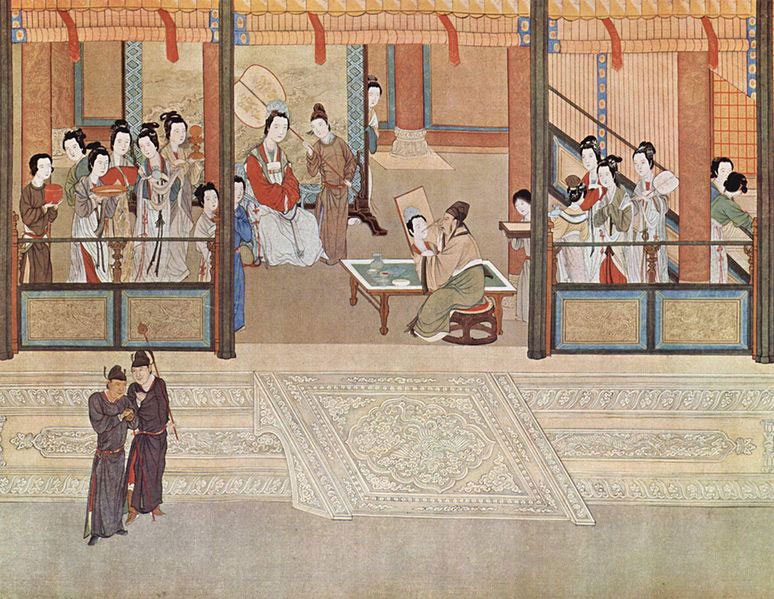
Cavorting in Ming pavilions
From 1405 – 1433 Chinese Ming Emperors funded a series of vii voyages into the Indian Bounding main to recover trade in the form of tribute from kingdoms in Southeast Asia.
They likewise wanted to re-enforce their claim to universal authority as well equally satisfy Europe'south increasing thirst for knowledge.
As in the courts and great houses of Europe at that place was a very rich and symbolical language which people read because they were visually aware and well acquainted with the stories. So it was the same in Prc.
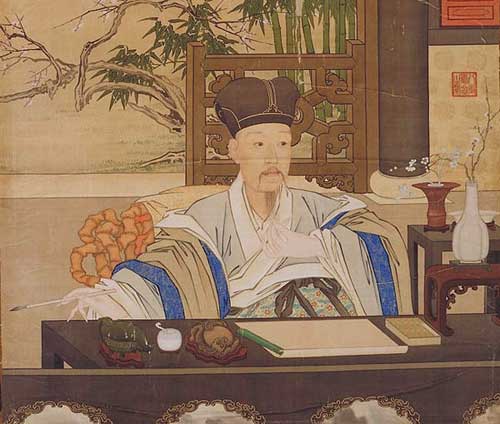
Emperor Ch'ien-lung (1711-1799) painted by a Jesuit priest Giuseppe Castiglione who lived at the court of three Chinese emperors and is renowned for introducing ideas of perspective into Chinese art
Past the late Ming Period c1573-1644 new developments in the aboriginal arts of calligraphy and painting occurred through mutual discussion and creative interaction.
The works the literati of Prc produced was all nearly heightening an awareness of the creative person equally an individual.
His position in the world and relationship with his peers was bodacious. Creative person scholars attained a loftier level of artistic merit, especially when it was tinged with extreme, poetic elegance that reflected a healthy attitude towards the development of art and society together
In 1368 when the Ming dynasty began, many scholars consider the supreme periods of its major arts including literature, calligraphy and painting were already passed

Wu Changshou - Peonies
Managing director of the NGV Tony Ellwood said "We are very pleased that this will be the first exhibition to get on brandish in the newly reopened Asian Art temporary exhibition gallery, a space which will host a rotating program of Asian Fine art exhibitions."
Three Perfections: Poetry, Painting and Calligraphy in Chinese Art
NGV International (180 St Kilda Rd, Melbourne)
6 Dec 2013 until ix June 2014
Open 10am – 5pm, closed Tuesdays. Costless Admission.
richardsonforescon.blogspot.com
Source: https://www.thecultureconcept.com/poetry-painting-calligraphy-in-chinese-art-perfection
0 Response to "2 In Ancient China Which Three Forms of Art Were Considered the Three Perfections?"
Postar um comentário